Nestled in the northwest corner of Connecticut, the town of Litchfield exudes colonial charm, picturesque views, and historic homes. Founded in 1856, the Litchfield Historical Society’s collection, which formally began in the 1890s, strongly reflects the early founders of the town and the prosperous times of the early 19th century.Did I mention the institution also has a collection of local modern artists?
The Historical Society’s first foray into modern art began in 1957 when the museum sponsored a local art exhibition.Over the next decade local artist such as Austin Purves, Peggy Reventlow, Nils Hogner and Stanley Mortimer exhibited their works for one week a year at the Center School cafeteria.Works could be purchased by visitors with part of the proceeds benefiting the museum.
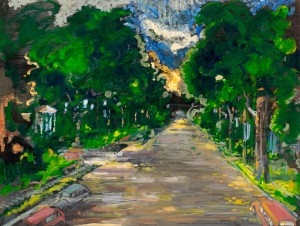
View Up North Street by Nils Hogner
In 1972, the Society became further involved with the local art movement when a fund was established by an anonymous donor for the purchase of contemporary art. In the Board President’s annual address for that year, Mrs. Sonia Seherr-Thoss commented on the fund,
A sum of money has been donated for the purchase of local contemporary works of art. The fund is not large but the donor expects to make this an annual gift. Our Litchfield area has many important artists and we would certainly be remiss as a Historical Society is we did not have a representative selection of their works. Mr. Rufus Stillman, who has a broad knowledge of the field and a most discerning eye, has agreed to serve as Chairman of Modern Acquisitions. I am sure we will all be watching with deep interest the growth of our contemporary collection and will enjoy the opportunity to study the creative activities of our regional artists.
Rufus Stillman was the natural choice to chair the Modern Acquisitions committee.He was a Litchfield resident who was interested in the modernist movement.In 1950, Stillman had hired Marcel Breuer to build his family home in Litchfield.Breuer went on to build three homes for Stillman as well as such public commissions as the Litchfield High School which was completed in 1960.
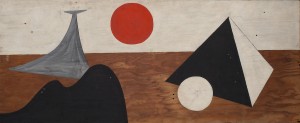
Untitled by Alexander Calder, oil on board
Stillman embraced his role as chair of the Modern Acquisitions committee traveling around Litchfield County and other parts of Connecticut purchasing works for the Historical Society. His enthusiasm spurred other local residents to donate items from their personal collections to the museum.
The committee and movement to include modern works of art in the Society’s collection were not without controversy. Soon after the committee had been established, Board President Sonia Seherr-Thoss proposed the creation of a permanent gallery space dedicated to the exhibition of modern art. This proposal was accepted but within months, community members vocally expressed doubts about its appropriateness. At the Annual Meeting held on September 14, 1973 the recording secretary noted this exchange,
Mrs. Eugene Dooman expressed dissatisfaction with the prominence of the Modern Acquisitions display and questioned the suitability of having modern art on exhibition in an historical society museum.Mrs. George Spencer stated on the basis of experience as a volunteer attendant she could only conclude that many visitors to the museum were definitely averse to it.
There followed a lively discussion in the course of which opinion on both sides of the issue was sharply divided, and at the conclusion of the discussion, the President and Mr. Edmondson agreed to attempt to work out some compromise in handling and rotating the display that would accommodate the different points of view.
It was during this same Annual Meeting that current Director William Warren publically announced his resignation from the position. In his letter to the Board he addressed a rumor that had been circulating concerning a possible reason for his decision to leave the institution,
The other rumor has it that I was angered by the idea of our being given works of art of contemporary regional artists. I am only too happy to deny this emphatically . . . No matter if one does not care for the major arts movements of today, the artists’ works do reflect the taste of the times, just as much as Ralph Earl reflected his.
Warren’s replacement, Lockett Ford Ballard did not appear to embrace the modern art collection as openly as his predecessor.In his director’s report dated October 25, 1974, Ballard listed the modern art collection as a “problem collection” and “considered by many inappropriate for exhibition in the museum proper.”He proposed creating a rotating display of examples from this collection at the Oliver Wolcott Library.The board agreed and the brief existence of an exhibition gallery dedicated to modern art at the Historical Society ended.
The evidence of this brief and controversial campaign to include modern art in the Historical Society’s collection remains though.As a result of the efforts of individuals like Rufus Stillman, Sonia Seherr-Thoss and others, the Historical Society can now count among its collection of paintings by Ralph Earl, George Catlin and Ammi Phillips, works by Robert Osborn, Alexander Calder, Robert J. Wolff, Cleve Gray, Donald Kaufman, Nils Hogner, Norman Ives, Doris Caesar, and Stanley Mortimer.
 Untitled by Doris Caesar, bronze
Untitled by Doris Caesar, bronze
While in recent years, the Society has not taken as active a role in collecting living artists’ works as it did in the early 1970s, the museum is entering into a new phase.The Historical Society hopes to create a partnership with the Litchfield Visual Arts.If approved, the LVA would organize a juried show of local artists to be held at the History Museum.The first exhibition would open in July 2010 and became an annual event.The shared goal of both organizations is to highlight Litchfield’s continual and vibrant artistic community.
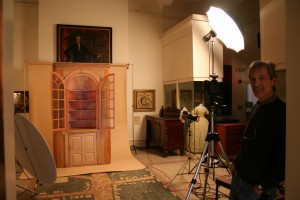 David Stansbury at right in the winter of 2008 as the Historical Society prepared for the publication of the exhibition catalog To Please Any Taste: Litchfield County Furniture & Furniture Makers, 1780-1830
David Stansbury at right in the winter of 2008 as the Historical Society prepared for the publication of the exhibition catalog To Please Any Taste: Litchfield County Furniture & Furniture Makers, 1780-1830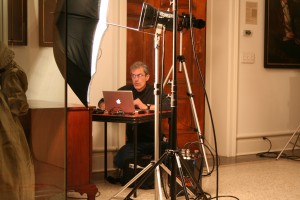 David as he adjusts an image on his computer
David as he adjusts an image on his computer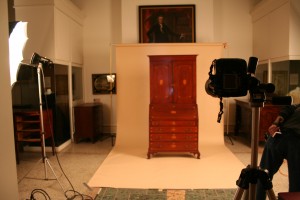 The photographer sessions are often held in the Liggett Gallery of the Litchfield History Museum. The large gallery provides ample space for the equipment
The photographer sessions are often held in the Liggett Gallery of the Litchfield History Museum. The large gallery provides ample space for the equipment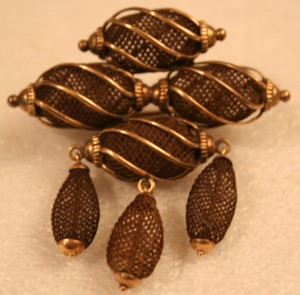 Mourning brooch made of human hair, 2006-41-1 Gift of Mr. and Mrs. Thomas Babbitt
Mourning brooch made of human hair, 2006-41-1 Gift of Mr. and Mrs. Thomas Babbitt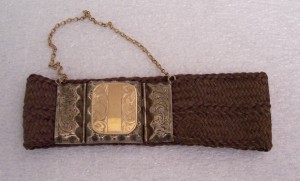
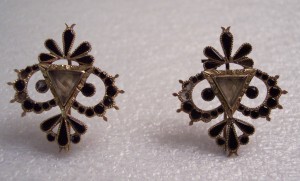
 Jewelry Box, C. Linherr Artist in Hair 577 Broadway New York City, Donor Unknown
Jewelry Box, C. Linherr Artist in Hair 577 Broadway New York City, Donor Unknown

 Untitled by Doris Caesar, bronze
Untitled by Doris Caesar, bronze You may have heard that the Litchfield Historical Society received a grant from the Council on Library and Information Resources for cataloging hidden special collections. The staff chose the
You may have heard that the Litchfield Historical Society received a grant from the Council on Library and Information Resources for cataloging hidden special collections. The staff chose the